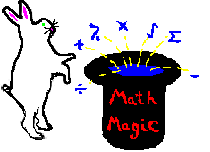

A. The Pythagorean Theorem (arguably the most famous theorem) states that if given a right triangle then the following is true:
c2 = a2 + b2, where a,b are the legs and c is the hypotenuse.
1. There are many famous triples that occur often on number sense tests and should therefore be memorized. The following table shows a limited list of Pythagorean triples in the form of (a,b,c)
| (3,4,5) | (5,12,13) | (6,8,10) |
| (7,24,25) | (8,15,17) | (9,12,15) |
| (9,40,41) | (11,60,61) | (20,21,29) |
2. It is important to note that all of these (with the exception of (20,21,29)) can be derived with a simple formula.
3. Also, if given a Pythagorean Triple, then multiplying that triple by a constant produces another Pythagorean Triple. For example, 2 x (3,4,5) = (6,8,10) which can be found in the table above.
B. Deriving Pythagorean Triples
1. In number sense, it is important to know how to derive Pythagorean Triples. If you are given one number, you can construct 2 other numbers that will form a Pythagorean Triple.
2. To do this, there are 2 situations. If the number is even and if the number is odd.
3. If the number 'n' is even then follow the steps below:
Divide n by 2.
Square this result.
The two numbers on either side represent the other leg and the hypotenuse required to make a Pythagorean Triple.
Ex [1] A right triangle has a side of 14. Find the hypotenuse.
14/2 = 7.
72 = 49.
The number 48 is the other leg and 50 is the hypotenuse.
The answer is 50.
To check if this is correct we can see if 142 + 482 = 502. 142 + 482 = 196 + 2304 = 2500 = 502. So it is correct.
4. If the number 'n' is odd then do the following:
Square n.
Find 2 consecutive numbers that add to equal the result in step a.
The smaller one is the other leg, the larger one is the hypotenuse.
Ex [1] A right triangle has a side of 13. Find the other leg.
132 = 169.
The two consecutive numbers that add to equal 169 are 84 and 85.
The answer is 85.
To check to see if this is right we can check 132 + 842 = 852. 132 + 842 = 169 + 6956 = 7225 = 852. So it is correct.
Note: Pythagorean Triples have many significant uses in number sense. It is important to know how to derive them.